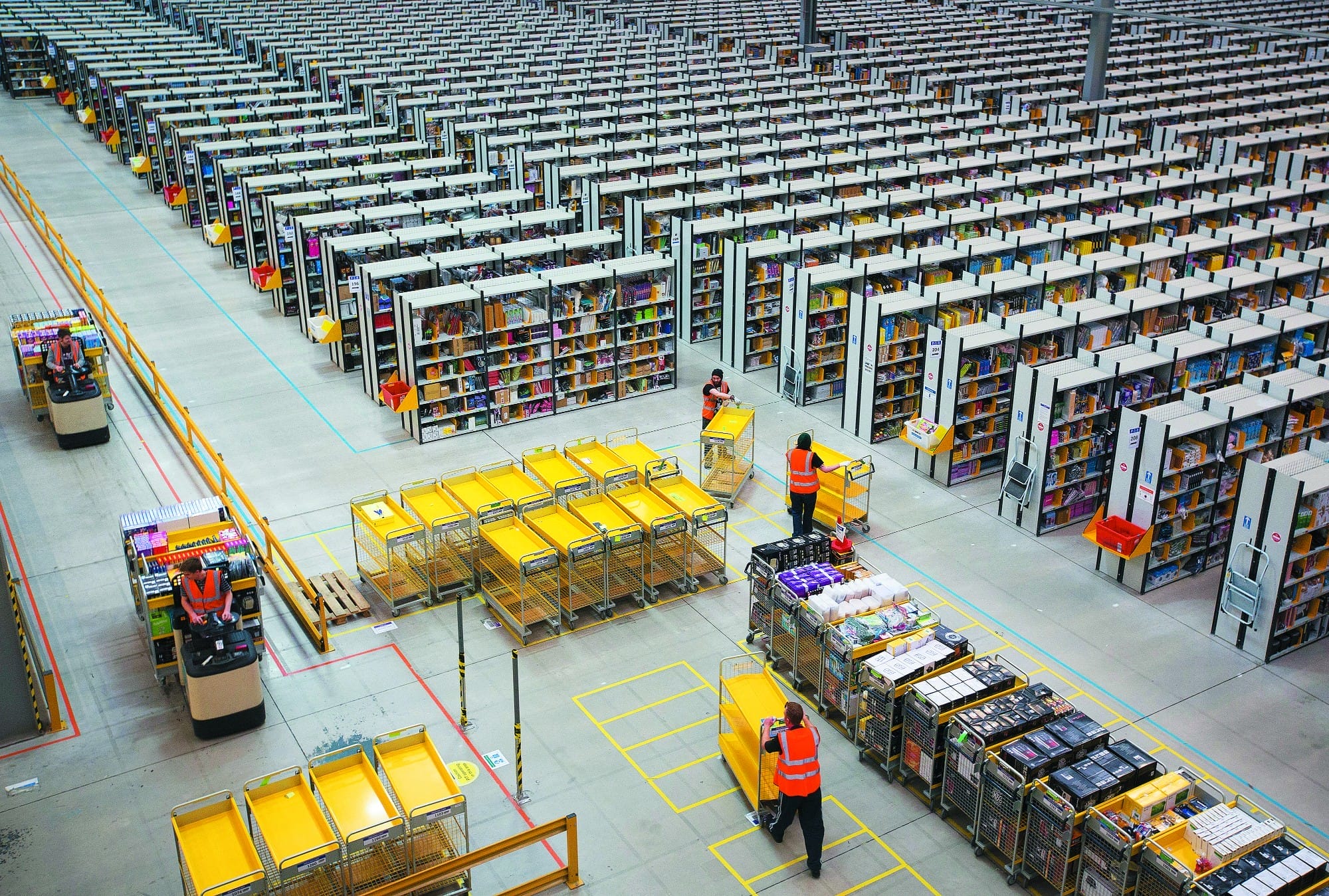In the media hullabaloo following Amazon’s announcement in June that it was buying Whole Foods Market, largely overlooked was the same-day news that Walmart was acquiring menswear e-tailer Bonobos. While Amazon made a bigger splash with its $13.7 billion foray into organic groceries, Walmart beefed up an e-commerce stable that already includes the acquisitions of digital natives Jet.com, ShoeBuy, ModCloth, and Moosejaw.
Collectively, these M&A deals have set Amazon, the world’s largest e-commerce company, on a collision course with Walmart, the world’s largest retailer, in a contest to become the “everything store” in an omnichannel world—one in which consumers no longer distinguish between shopping online and off. It pits two baby boomer mavericks, Amazon CEO Jeff Bezos and Whole Foods CEO John Mackey, against Wharton’s own Marc Lore, Walmart’s e-commerce chief and the Gen X founder of Jet.com.
“You can see they’re coming at each other,” says Barbara Kahn, Wharton marketing professor and director of the school’s Jay H. Baker Retailing Center. The Amazon deal is “clearly a big play into the food business,” she says, noting that food items are one of the most frequently purchased goods. In buying Whole Foods, Amazon hits Walmart squarely where it hurts: 56 percent of its U.S. sales come from food and grocery items. Amazon now adds Whole Foods to its other food operations: AmazonFresh, Prime Now, Prime Pantry, Amazon Go, and AmazonFresh Pickup.
As Amazon adds offline capabilities, Walmart is acquiring digital talent. Kahn credits Lore for Walmart’s aggressive acquisition spree of digital brands, noting that he “understood tech in a way that Walmart just couldn’t within its own culture.” Since joining Walmart, she adds, Lore has increased sales. And the digital talent bench will deepen further with Bonobos’s millennial CEO, Andy Dunn, coming on board and reporting to Lore: “They’re going to be figuring out how to put all this together. It’s kind of a brand-new world. You’re talking about really reinventing retail.”
Amazon takes a page from Chinese e-commerce giant Alibaba, which has invested more than $9.3 billion in offline stores since 2015, according to Reuters. In the U.S., Alibaba hasn’t had much of an impact. It sold its U.S. unit, 11main.com, in 2015—just one year into its launch. Alibaba has said that its international strategy is focused on enabling merchants to sell into the Chinese market, instead of competing head-on with Amazon and others. Amazon has no such reservations. In 2016, it began offering free shipping to Chinese Prime members, among other moves.
Offline Still Matters
David Bell, a Wharton marketing professor, says the Whole Foods acquisition proves that “offline retail is absolutely not dead. Offline retail is just going to look different in the future.” For a long time, though, people have been ringing the death knell for all types of brick-and-mortar stores. “A lot of people thought e-commerce was going to kill traditional retail, so if you were digital-first, you would never get into offline. Of course, it’s not true. But that’s been a slower realization to take place.”
In an omnichannel matchup, Amazon has the advantage over Walmart, Bell says: “From my experience, companies that start in the digital world and slowly and surely add offline have been more successful than companies that started in the offline world and added digital.” He says it’s easier, for example, for eyeglass e-tailer Warby Parker to open an offline store than for an optical shop to add a fully integrated digital experience. Since Amazon has “all this digital DNA and digital knowledge, they will presumably create the offline experience relevant to 2017 and not 1967,” Bell adds. “That’s the big difference.”
But don’t count Walmart out just yet. It may have started old-school, but it has offline scale. While Amazon now has about 460 Whole Foods stores, that’s dwarfed by Walmart’s nearly 4,700 stores in the U.S., including some 660 Sam’s Club locations. Amazon has 340,000 employees, and Whole Foods has added another 87,000, but Walmart employs more than 1.5 million people in the country. In the rivals’ latest reported annual revenue, Amazon booked $136 billion, while Whole Foods posted $15.7 billion. Walmart was at $485.3 billion. But the story reverses when it comes to growth: Walmart sales rose 0.8 percent year-over-year, and Whole Foods rose 2.2 percent while Amazon roared ahead by 27 percent.
Still, Amazon has problems to fix at Whole Foods. The grocer posted seven straight quarters of falling same-store sales at locations open at least a year—a key retail metric—as rivals sold organic food at lower prices. Another problem is that Whole Foods lags in analytics and tech capabilities, among other ills, according to hedge fund Jana Partners, a major shareholder that threatened a proxy battle if performance didn’t improve. “Whole Foods still has a good brand name, but revenues have slowed, and it is a pretty mature grocery brand at this point,” says Wharton emeritus marketing professor Stephen Hoch.
Omnichannel Strategies
Whatever challenges Amazon faces with integrating Whole Foods, strategically, the deal was “brilliant,” says Jerry Wind, a Wharton emeritus marketing professor. “It’s a logical step for [grocery service] AmazonFresh.” Amazon now has stores in urban areas that can serve as distribution points for AmazonFresh, as well as pickup centers for apparel and other goods. “Consumers can buy online at Amazon and pick up in Whole Foods,” adds Xuanming Su, Wharton professor of operations, information and decisions. “This whole omnichannel battle is going to end up giving consumers a lot more options.”
In the future, Amazon could upgrade Whole Foods with innovative retail technologies in use at its fully automated experimental store, Amazon Go, where shoppers pick up their food and leave. There are no cashiers or checkout lines; Amazon tracks what’s taken and put back and charges their accounts. “Just imagine the power of this and how far ahead of other retailers Amazon-Whole Foods will be when they introduce this new system,” Wind says.
Denise Dahlhoff, research director at the Jay H. Baker Retailing Center, says Amazon and Whole Foods also complement each other. “Amazon brings its expertise in supply chain, data, and technology to the table, and they are super customer-oriented,” she says. “Whole Foods brings its expertise in healthy food, and … stores in very attractive urban areas that are heavily frequented by a higher-income customer segment. The brand is also about community and the in-store experience—the rich, sensual experience you get by seeing nice displays of food, produce, and baked goods.” This sensory experience is something Amazon cannot provide by selling goods online.
With Whole Foods stores, Amazon removes some headaches in online grocery delivery. Dahlhoff says many shoppers still prefer to personally pick their own produce and fresh meat, something AmazonFresh can’t offer. Also, delivery of online groceries can get complicated because some items only need to be kept cool, while others have to stay frozen—which means additional packaging and weight. “That creates a lot of complexity,” she adds. Moreover, “Having these offline locations would not only help their grocery business, but also the rest of Amazon’s business by providing locations for returns. Just think of fashion items.” [In late September, Amazon announced its customers will be able to return purchases at Kohl’s locations.]
In addition, Amazon can deploy data analytics to customize services to make life easier for shoppers. For example, if Amazon knows what a customer buys every two weeks, it can create a grocery list ahead of time, Dahlhoff says. For its part, Whole Foods brings its relationships with local vendors that offer unique items. Amazon can give these merchants more exposure and scale. It could also add more private-label goods (now sold on its website) to Whole Foods’ smaller, less-expensive stores, called 365.
Amazon and Whole Foods target similar consumers as well. Dahlhoff says close to 80 percent of Whole Foods shoppers also buy from Amazon—and cross-selling goods will be easier. Walmart, on the other hand, targets a different customer than those of its acquired upscale e-tailers, so it faces more challenges in reconciling all these brands. A good strategy would be to keep the brands separate and not link them too closely with Walmart, she says. Indeed, the Jet.com website doesn’t sport Walmart’s logo and only mentions the discounter in a listing of job openings.
Whole Foods is known for its higher food prices (earning it the nickname “Whole Paycheck”), but in late August, it slashed prices as much as 43 percent; as a result, sales rose by around 25 percent. But Dahlhoff thinks those cuts may not necessarily indicate a new price-focused strategy for the grocer: “An objective of the price cuts seems to be to change Whole Foods’ perception as a premium-priced store. While the perception of Amazon is that of low price, some studies have shown it’s competitive on popular items but not necessarily on others. This could be the same strategy for Whole Foods.”
Amazon retains customers through a “classic two-part tariff model” of charging a flat fee for Prime membership and then “basically selling goods at marginal cost,” Hoch says. “All of their profit, to the extent there is any, is due to the fixed fee.” Another retailer that successfully uses this model is Costco, he says: “Both retailers sacrifice short-term profit for long-term growth and then use that scale to crush their competitors with low prices.”
Next Move: Walmart?
Walmart, of course, has traditionally focused on price and caters to a different customer from Amazon: typically lower-income, budget-conscious households. While it has acquired some higher-end e-tailers such as Bonobos, these remain a small part of its business, Hoch says. Walmart and Whole Foods also serve different customers with little overlap, “given Whole Foods Market’s higher-quality focus and distinct target markets,” he adds. “I don’t see much change on that front in the short to medium term.”
Meanwhile, Walmart has been changing, too. It’s innovating on the back end to leverage its large distribution network. Lore introduced a pilot program to let employees deliver packages on their way home for extra pay, to take advantage of the fact that Walmart has stores within 10 miles of 90 percent of Americans. “If they now can use that same infrastructure to get stuff to the e-commerce users by using their employees to do the ‘last mile,’ that’s going to be hard for Amazon to duplicate,” says Leonard Lodish, Wharton emeritus marketing professor. The “last mile” to the customer’s doorstep is the most expensive part of delivery.
Wind thinks Walmart’s tactics are “a little confusing and a little late” as it tries to catch up with online merchants. But he notes that with its scale and track record of success, the discounter will eventually become digitally savvy. Meanwhile, though the early indicators are positive, Amazon risks making changes to Whole Foods too quickly, Dahlhoff says. Adds Lodish: “I’m not sure how much experience Amazon has in running a big operation like Whole Foods that’s got a lot of logistics that are not in warehouses but are on shelves.”
At least Amazon could afford the $13.7 billion price tag for Whole Foods—last year’s free cash flow was $9.7 billion. And Wall Street will likely be kind to Amazon because it has a proven business model and an innovative CEO. Says Lodish: “The market has been giving Jeff Bezos room to do what he feels is in the long-term best interest [of the company]. They’re not punishing him if he has short-term uses for his capital that don’t go to the bottom line right away.”
Published as “Clash of the Titans” in the Fall/Winter 2017 issue of Wharton Magazine.


























